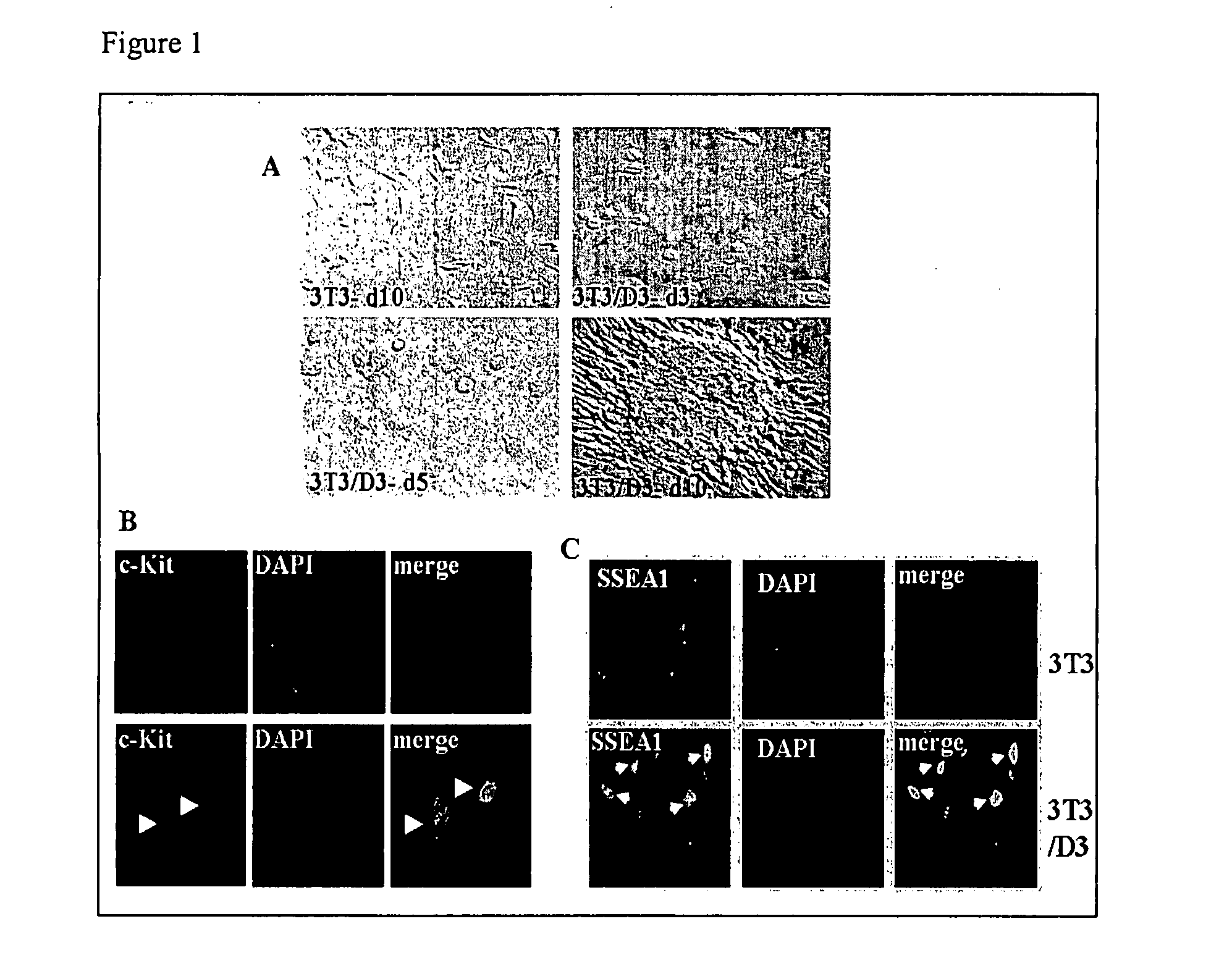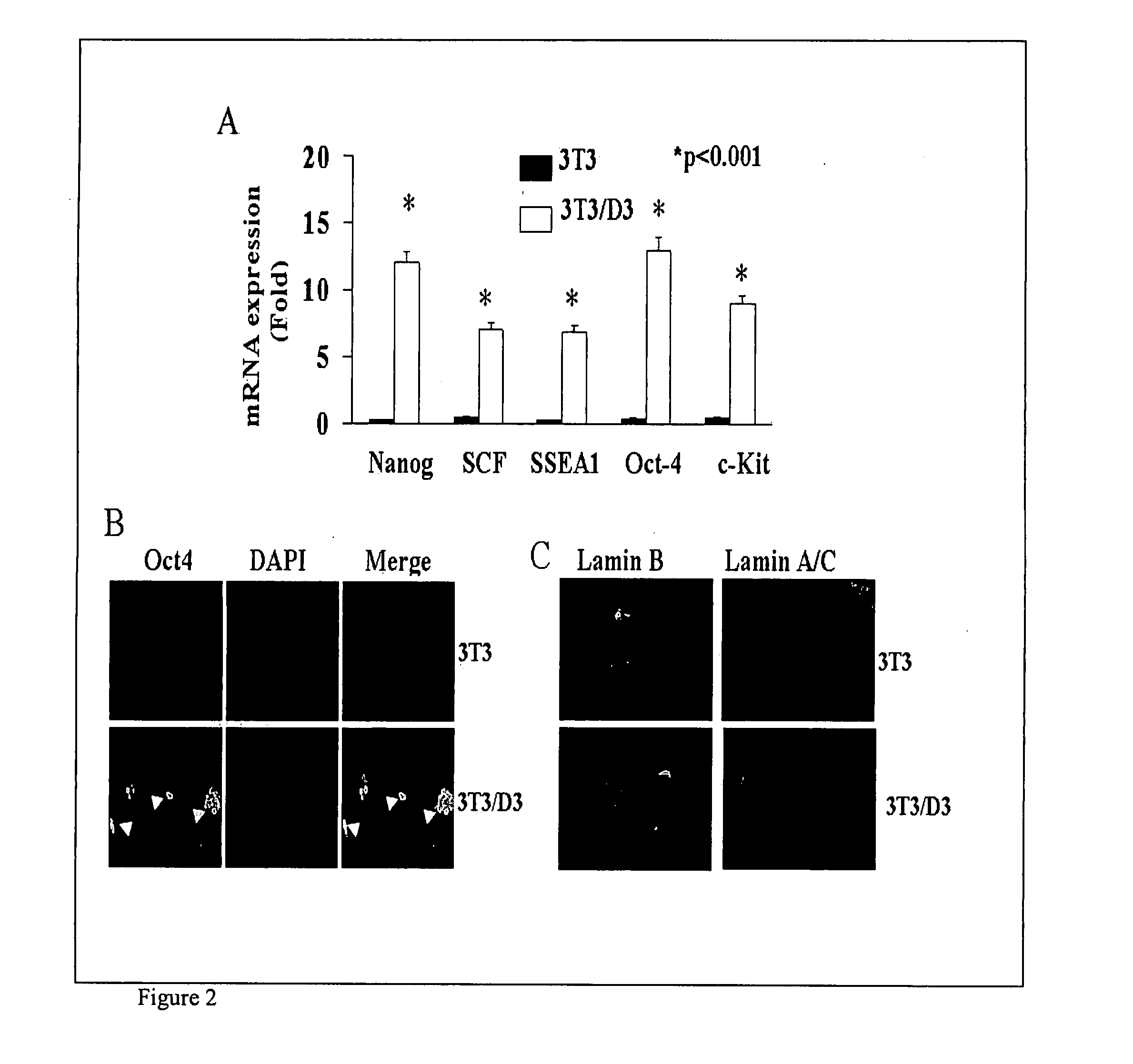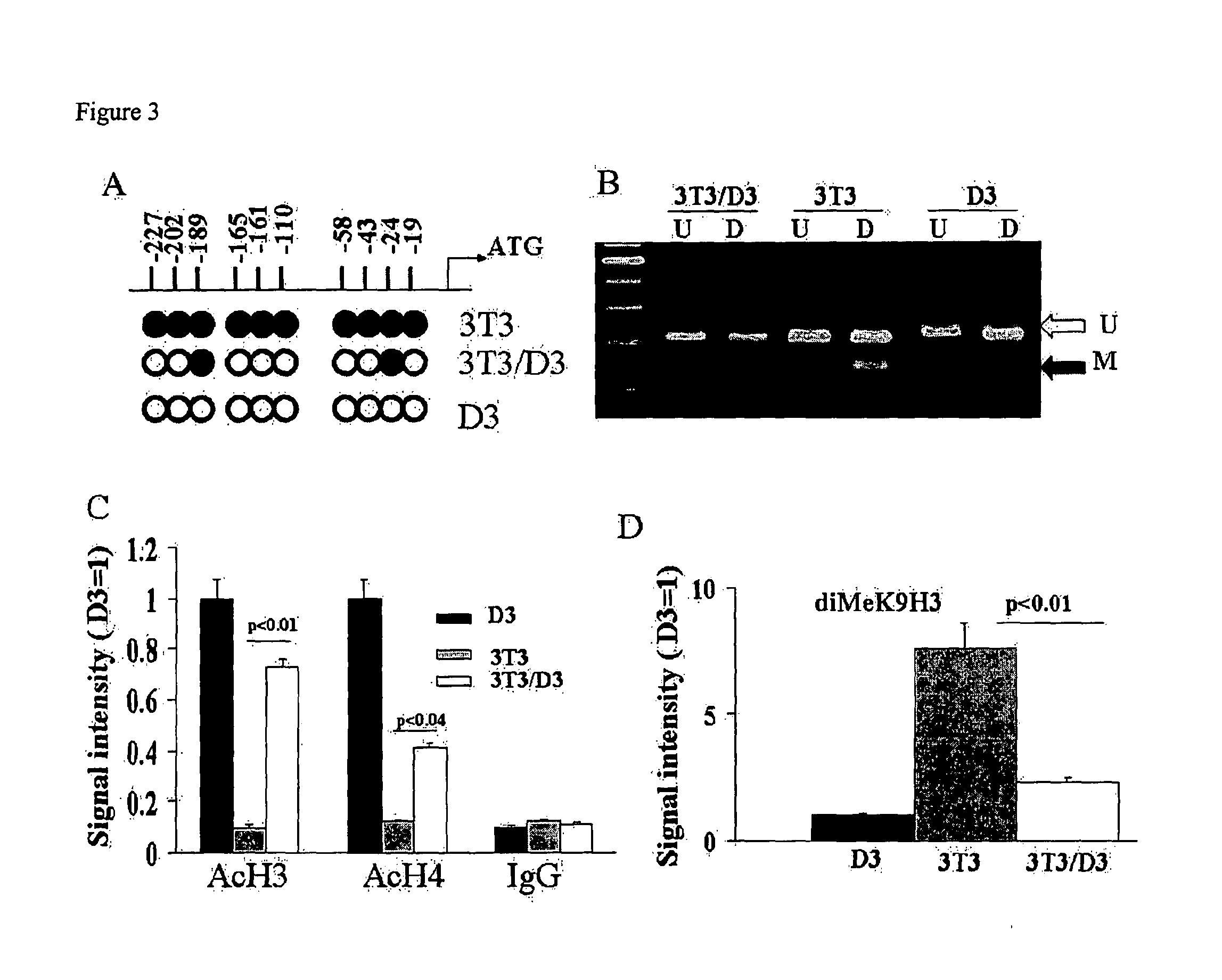[0008]In yet another aspect, the invention provides a method of ameliorating a cardiovascular condition in a subject in need thereof, the method involves contacting a
somatic cell containing a permeable
cell membrane with an
embryonic stem cell extract; culturing the
cell in the presence of LIF and BMP-2, to generate a cardiomyocyte; and injecting the cardiomyocyte of the previous step into a
muscle tissue of the subject, thereby ameliorating a cardiovascular condition. In one embodiment, the method increases left
ventricular function, reduces
fibrosis, or increases capillary density in a cardiac tissue of the subject. In another embodiment, the contacting is carried out in an ATP regenerating buffer. In yet another embodiment, the method further involves expressing a recombinant
protein (e.g.,
activin A,
adrenomedullin, acidic FGF,
basic fibroblast growth factor,
angiogenin,
angiopoietin-1,
angiopoietin-2,
angiopoietin-3, angiopoietin-4,
angiostatin, angiotropin, angiotensin-2, bone morphogenic
protein 1, 2, or 3,
cadherin, collagen,
colony stimulating factor (CSF), endothelial
cell-derived
growth factor, endoglin, endothelin,
endostatin,
endothelial cell growth inhibitor, endothelial cell-viability maintaining factor, ephrins,
erythropoietin,
hepatocyte growth factor,
human growth hormone, TNF-alpha, TGF-beta,
platelet derived
endothelial cell growth factor (PD-ECGF),
platelet derived endothelial
growth factor (PDGF),
insulin-like growth factor-1 or -2 (IGF),
interleukin (IL)-1 or 8, FGF-5,
fibronectin,
granulocyte macrophage colony stimulating factor (GM-CSF), heart derived inhibitor of vascular cell proliferation, IFN-gamma, IGF-2, IFN-gamma,
integrin receptor, LIF, leiomyoma-derived growth factor, MCP-1, macrophage-derived growth factor,
monocyte-derived growth factor, MMP 2, MMP3, MMP9,
neuropilin, neurothelin,
nitric oxide donors,
nitric oxide synthase (NOS),
stem cell factor (SCF), VEGF-A, VEGF-B, VEGF-C, VEGF-D, VEGF-E, VEGF, and VEGF164) in the cell. In yet another embodiment, the recombinant
protein is a polypeptide that promotes cell proliferation or differentiation. In one embodiment, the recombinant protein is a reporter protein (e.g., GFP, EGFP, BFP, CFP, YFP, and RFP).
[0013]In various embodiments of any previous aspect, the subject has damage to the tissue or organ, and the administering provides a
dose of cells sufficient to increase a biological function of the tissue or organ. In still other embodiments of the previous aspects, the subject has a
disease, disorder, or condition, and wherein the administering provides a
dose of cells sufficient to ameliorate or stabilize the
disease, disorder, or condition. the method increases the number of cells of the tissue or organ by at least about 5%, 10%, 25%, 50%, 75% or more compared to a corresponding
untreated control tissue or organ. In still other embodiments of the previous aspects, the method increases the
biological activity of the tissue or organ by at least about 5%, 10%, 25%, 50%, 75% or more compared to a corresponding
untreated control tissue or organ. In still other embodiments of the previous aspects, the method increases
blood vessel formation in the tissue or organ by at least about 5%, 10%, 25%, 50%, 75% or more compared to a corresponding
untreated control tissue or organ. In still other embodiments of the previous aspects, the cell is administered directly to a subject at
a site where an increase in
cell number is desired. In still other embodiments of the previous aspects, the site is
a site of
tissue damage or
disease. In still other embodiments of the previous aspects, the site shows an increase in cell death relative to a corresponding control site. In still other embodiments of the previous aspects, the subject has a disease that is any one or more of
myocardial infarction, congestive
heart failure,
stroke,
ischemia,
peripheral vascular disease,
alcoholic liver disease,
cirrhosis, Parkinson's disease, Alzheimer's disease, diabetes,
cancer,
arthritis, and
wound healing. In still other embodiments of the previous aspects, the method ameliorates ischemic damage. In still other embodiments of the previous aspects, the method reduces
apoptosis, increases cell proliferation, increases function, or increases
perfusion of
muscle tissue (e.g., cardiac tissue or
skeletal muscle tissue). In still other embodiments, the method repairs post-infarct ischemic damage in a cardiac tissue. In still other embodiments, the method repairs hind
limb ischemia in a
skeletal muscle tissue. In still other embodiments, the cell is any of the following: a cardiomyocyte that expresses a cardiomyocyte marker that is any one or more of
connexin43, Mef2C, Nkx2.5, GATA4,
cardiac troponin I,
cardiac troponin T, and Tbx5; an endothelial cell that expresses an endothelial marker that is CD31 or Flk-1; a neuronal cell that expresses a neuronal marker that is nestin or β-
tubulin; or an
adipocyte cell that is positive for
Oil red O.
 Login to View More
Login to View More 


